Content for TS 24.501 Word version: 19.1.1
1…
3…
4…
4.4…
4.4.3…
4.5…
4.5.3…
4.6…
4.7…
4.9…
4.15…
5…
5.2…
5.3…
5.3.2…
5.3.7…
5.3.19…
5.4…
5.4.1.3…
5.4.2…
5.4.4…
5.4.5…
5.4.6…
5.5…
5.5.1.2.4
5.5.1.2.5…
5.5.1.3…
5.5.1.3.4
5.5.1.3.5…
5.5.2…
5.6…
5.6.2…
6…
6.1.4…
6.2…
6.3…
6.3.2…
6.3.3…
6.4…
6.4.1.4…
6.4.2…
6.5…
7…
8…
8.2.9…
8.3…
9…
9.11.2…
9.11.2.10…
9.11.3…
9.11.3.4…
9.11.3.8…
9.11.3.14…
9.11.3.18C…
9.11.3.29…
9.11.3.33…
9.11.3.39…
9.11.3.45…
9.11.3.50…
9.11.3.53A…
9.11.3.68…
9.11.3.75…
9.11.4…
9.11.4.10…
9.11.4.13…
9.11.4.16…
9.11.4.30…
9.12
10…
A…
B…
C…
D…
D.6…
D.6.3…
D.6.8
D.7…
9.11.3.53A UE parameters update transparent container
9.11.3.54 UE security capability
9.11.3.55 UE's usage setting
9.11.3.56 UE status
9.11.3.57 Uplink data status
...
...
9.11.3.53A UE parameters update transparent container p. 973
The purpose of the UE parameters update transparent container when sent from the network to the UE is to provide UE parameters update data, optional acknowledgement request and optional re-registration request. The purpose of the UE parameters update transparent container when sent from the UE to the network is to indicate the UE acknowledgement of successful reception of the UE parameters update transparent container.
The UE parameters update transparent container information element is coded as shown in Figure 9.11.3.53A.1, Figure 9.11.3.53A.2, Figure 9.11.3.53A.3, Figure 9.11.3.53A.4, Figure 9.11.3.53A.4A, Figure 9.11.3.53A.4B, Figure 9.11.3.53A.5, Figure 9.11.3.53A.6, Figure 9.11.3.53A.7 and Table 9.11.3.53A.1.
The UE parameters update transparent container is a type 6 information element with a minimum length of 20 octets.
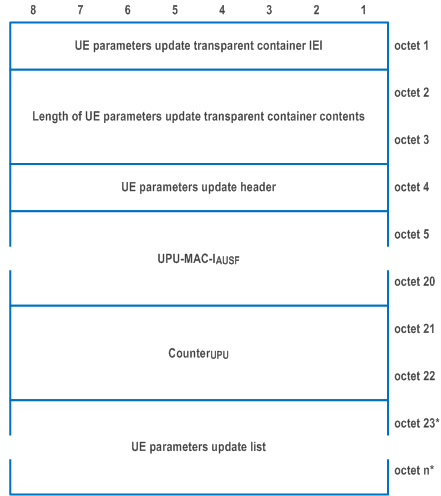
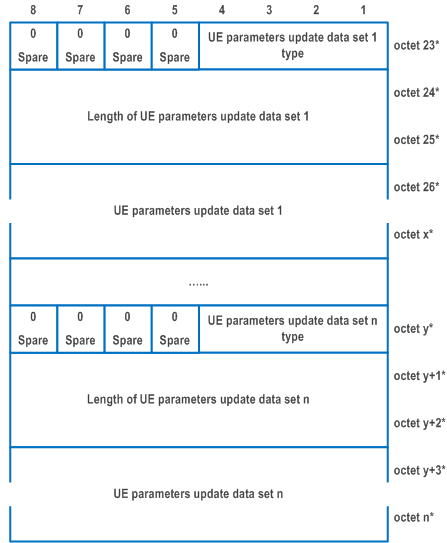




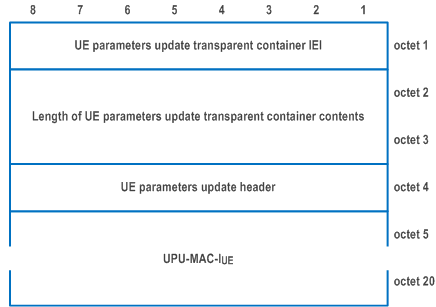


| UPU-MAC-IAUSF, UPU-MAC-IUE and CounterUPU are coded as specified in TS 33.501 | |
| UPU data type (octet 4, bit 1) | |
| 0 | The UE parameters update transparent container carries a UE parameters update list (NOTE 2) |
| 1 | The UE parameters update transparent container carries an acknowledgement of successful reception of a UE parameters update list (NOTE 2) |
| Acknowledgement (ACK) value (octet 4, bit 2) | |
| 0 | acknowledgement not requested |
| 1 | acknowledgement requested |
| Re-registration (REG) value (octet 4, bit 3) | |
| 0 | re-registration not requested |
| 1 | re-registration requested |
| UE parameters update data set type | |
| Bits
4 3 2 1 | |
| 0 0 0 1 | Routing indicator update data |
| 0 0 1 0 | Default configured NSSAI update data |
| 0 0 1 1 | Disaster roaming information update data |
| 0 1 0 0 | ME routing indicator update data |
| All other values are reserved | |
| Disaster Roaming Enabled Indication (DREI) value (octet d*, bit 1) | |
| 0 | Disaster roaming is disabled in the UE |
| 1 | Disaster roaming is enabled in the UE |
| Indication of 'applicability of "lists of PLMN(s) to be used in disaster condition" provided by a VPLMN' (AOL) value (octet d*, bit 2) | |
| 0 | false |
| 1 | true |
| The secured packet is coded as specified in TS 31.115. The default configured NSSAI is encoded as the value part of the NSSAI IE (see subclause 9.11.3.37). Routing indicator Routing indicator is encoded as the routing indicator field of the 5GS mobile identity IE (see subclause 9.11.3.4). | |
|
NOTE 1:
When the routing indicator is updated, if the SNPN uses the EAP based primary authentication and key agreement procedure using the EAP-AKA' or the 5G AKA based primary authentication and key agreement procedure, then UE parameter update data set type is set to "routing indicator update data", otherwise, UE parameter update data set type is set to "ME routing indicator update data".
NOTE 2:
The UPU data type set to "0" is used in the network to UE direction. The UPU data type set to "1" is used in the UE to network direction.
|
|
9.11.3.54 UE security capability p. 976
The UE security capability information element is used by the UE and by the network to indicate which security algorithms are supported by the UE in N1 mode for NAS security as well as which security algorithms are supported over NR and E-UTRA connected to 5GCN for AS security.
The UE security capability information element is coded as shown in Figure 9.11.3.54.1 and Table 9.11.3.54.1.
The UE security capability is a type 4 information element with a minimum length of 4 octets and a maximum length of 10 octets.
Octets 5 to 10 are optional. If octet 5 is included, then also octet 6 shall be included.
If the UE does not support any security algorithm for AS security over E-UTRA connected to 5GCN, it shall not include octets 5 and 6. The UE shall not include octets 7 to 10.
If the UE does not support any security algorithm for AS security over E-UTRA connected to 5GCN, and if the network includes octets 7 to 10, then the network shall also include octets 5 to 6.
If the network includes octet 7, then it shall include also octet 8. If the network includes octet 9, then it shall include also octet 10.
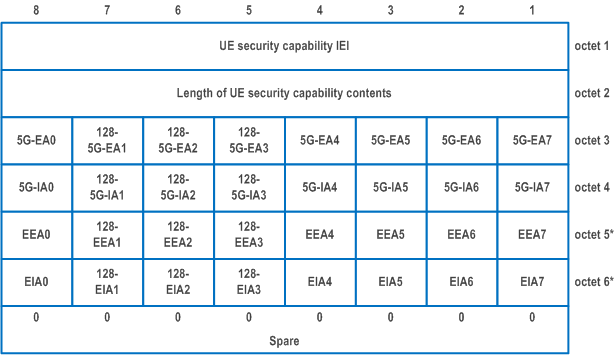
| 5GS encryption algorithms supported (see NOTE 1) (octet 3) | |
| 5GS encryption algorithm 5G-EA0 supported (octet 3, bit 8) | |
| 0 | 5GS encryption algorithm 5G-EA0 not supported |
| 1 | 5GS encryption algorithm 5G-EA0 supported |
| 5GS encryption algorithm 128-5G-EA1 supported (octet 3, bit 7) | |
| 0 | 5GS encryption algorithm 128-5G-EA1 not supported |
| 1 | 5GS encryption algorithm 128-5G-EA1 supported |
| 5GS encryption algorithm 128-5G-EA2 supported (octet 3, bit 6) | |
| 0 | 5GS encryption algorithm 128-5G-EA2 not supported |
| 1 | 5GS encryption algorithm 128-5G-EA2 supported |
| 5GS encryption algorithm 128-5G-EA3 supported (octet 3, bit 5) | |
| 0 | 5GS encryption algorithm 128-5G-EA3 not supported |
| 1 | 5GS encryption algorithm 128-5G-EA3 supported |
| 5GS encryption algorithm 5G-EA4 supported (octet 3, bit 4) | |
| 0 | 5GS encryption algorithm 5G-EA4 not supported |
| 1 | 5GS encryption algorithm 5G-EA4 supported |
| 5GS encryption algorithm 5G-EA5 supported (octet 3, bit 3) | |
| 0 | 5GS encryption algorithm 5G-EA5 not supported |
| 1 | 5GS encryption algorithm 5G-EA5 supported |
| 5GS encryption algorithm 5G-EA6 supported (octet 3, bit 2) | |
| 0 | 5GS encryption algorithm 5G-EA6 not supported |
| 1 | 5GS encryption algorithm 5G-EA6 supported |
| 5GS encryption algorithm 5G-EA7 supported (octet 3, bit 1) | |
| 0 | 5GS encryption algorithm 5G-EA7 not supported |
| 1 | 5GS encryption algorithm 5G-EA7 supported |
| 5GS integrity algorithms supported (see NOTE 2) (octet 4) | |
| 5GS integrity algorithm 5G-IA0 supported (octet 4, bit 8) | |
| 0 | 5GS integrity algorithm 5G-IA0 not supported |
| 1 | 5GS integrity algorithm 5G-IA0 supported |
| 5GS integrity algorithm 128-5G-IA1 supported (octet 4, bit 7) | |
| 0 | 5GS integrity algorithm 128-5G-IA1 not supported |
| 1 | 5GS integrity algorithm 128-5G-IA1 supported |
| 5GS integrity algorithm 128-5G-IA2 supported (octet 4, bit 6) | |
| 0 | 5GS integrity algorithm 128-5G-IA2 not supported |
| 1 | 5GS integrity algorithm 128-5G-IA2 supported |
| 5GS integrity algorithm 128-5G-IA3 supported (octet 4, bit 5) | |
| 0 | 5GS integrity algorithm 128-5G-IA3 not supported |
| 1 | 5GS integrity algorithm 128-5G-IA3 supported |
| 5GS integrity algorithm 5G-IA4 supported (octet 4, bit 4) | |
| 0 | 5GS integrity algorithm 5G-IA4 not supported |
| 1 | 5GS integrity algorithm 5G-IA4 supported |
| 5GS integrity algorithm 5G-IA5 supported (octet 4, bit 3) | |
| 0 | 5GS integrity algorithm 5G-IA5 not supported |
| 1 | 5GS integrity algorithm 5G-IA5 supported |
| 5GS integrity algorithm 5G-IA6supported (octet 4, bit 2) | |
| 0 | 5GS integrity algorithm 5G-IA6 not supported |
| 1 | 5GS integrity algorithm 5G-IA6 supported |
| 5GS integrity algorithm 5G-IA7 supported (octet 4, bit 1) | |
| 0 | 5GS integrity algorithm 5G-IA7 not supported |
| 1 | 5GS integrity algorithm 5G-IA7 supported |
| EPS encryption algorithms supported (see NOTE 3) (octet 5) | |
| EPS encryption algorithm EEA0 supported (octet 5, bit 8) | |
| 0 | EPS encryption algorithm EEA0 not supported |
| 1 | EPS encryption algorithm EEA0 supported |
| EPS encryption algorithm 128-EEA1 supported (octet 5, bit 7) | |
| 0 | EPS encryption algorithm 128-EEA1 not supported |
| 1 | EPS encryption algorithm 128-EEA1 supported |
| EPS encryption algorithm 128-EEA2 supported (octet 5, bit 6) | |
| 0 | EPS encryption algorithm 128-EEA2 not supported |
| 1 | EPS encryption algorithm 128-EEA2 supported |
| EPS encryption algorithm 128-EEA3 supported (octet 5, bit 5) | |
| 0 | EPS encryption algorithm 128-EEA3 not supported |
| 1 | EPS encryption algorithm 128-EEA3 supported |
| EPS encryption algorithm EEA4 supported (octet 5, bit 4) | |
| 0 | EPS encryption algorithm EEA4 not supported |
| 1 | EPS encryption algorithm EEA4 supported |
| EPS encryption algorithm EEA5 supported (octet 5, bit 3) | |
| 0 | EPS encryption algorithm EEA5 not supported |
| 1 | EPS encryption algorithm EEA5 supported |
| EPS encryption algorithm EEA6 supported (octet 5, bit 2) | |
| 0 | EPS encryption algorithm EEA6 not supported |
| 1 | EPS encryption algorithm EEA6 supported |
| EPS encryption algorithm EEA7 supported (octet 5, bit 1) | |
| 0 | EPS encryption algorithm EEA7 not supported |
| 1 | EPS encryption algorithm EEA7 supported |
| EPS integrity algorithms supported (see NOTE 4) (octet 6) | |
| EPS integrity algorithm EIA0 supported (octet 6, bit 8) | |
| 0 | EPS integrity algorithm EIA0 not supported |
| 1 | EPS integrity algorithm EIA0 supported |
| EPS integrity algorithm 128-EIA1 supported (octet 6, bit 7) | |
| 0 | EPS integrity algorithm 128-EIA1 not supported |
| 1 | EPS integrity algorithm 128-EIA1 supported |
| EPS integrity algorithm 128-EIA2 supported (octet 6, bit 6) | |
| 0 | EPS integrity algorithm 128-EIA2 not supported |
| 1 | EPS integrity algorithm 128-EIA2 supported |
| EPS integrity algorithm 128-EIA3 supported (octet 6, bit 5) | |
| 0 | EPS integrity algorithm 128-EIA3 not supported |
| 1 | EPS integrity algorithm 128-EIA3 supported |
| EPS integrity algorithm EIA4 supported (octet 6, bit 4) | |
| 0 | EPS integrity algorithm EIA4 not supported |
| 1 | EPS integrity algorithm EIA4 supported |
| EPS integrity algorithm EIA5 supported (octet 6, bit 3) | |
| 0 | EPS integrity algorithm EIA5 not supported |
| 1 | EPS integrity algorithm EIA5 supported |
| EPS integrity algorithm EIA6 supported (octet 6, bit 2) | |
| 0 | EPS integrity algorithm EIA6 not supported |
| 1 | EPS integrity algorithm EIA6 supported |
| EPS integrity algorithm EIA7 supported (octet 6, bit 1) | |
| 0 | EPS integrity algorithm EIA7 not supported |
| 1 | EPS integrity algorithm EIA7 supported |
| For the UE not supporting any security algorithm for AS security over E-UTRA connected to 5GCN, all bits in octets 5 to 10 are spare and shall be ignored, if the respective octet is received with the information element. For the UE supporting at least one security algorithm for AS security over E-UTRA connected to 5GCN all bits in octets 7 to 10 are spare and shall be ignored, if the respective octet is received with the information element. If the AMF receives any of the octets 7 to 10 (NOTE 5), it shall store the octets as received and include them when sending the UE security capability information element to the UE. | |
|
NOTE 1:
The code points in octet 3 are used to indicate support for 5GS encryption algorithms for NAS security in N1 mode and support for 5GS encryption algorithms for AS security over NR.
NOTE 2:
The code points in octet 4 are used to indicate support for 5GS integrity algorithms for NAS security in N1 mode and support for 5GS integrity algorithms for AS security over NR.
NOTE 3:
The code points in octet 5 are used to indicate support for EPS encryption algorithms for AS security over E-UTRA connected to 5GCN.
NOTE 4:
The code points in octet 6 are used to indicate support for EPS integrity algorithms for AS security over E-UTRA connected to 5GCN.
NOTE 5:
The AMF can receive this information element also from another AMF or MME during N1 mode to N1 mode or S1 mode to N1 mode handover preparation.
|
|
9.11.3.55 UE's usage setting p. 981
The purpose of the UE's usage setting information element is to provide the network with the UE's usage setting as defined in TS 24.301. The network uses the UE's usage setting to select the RFSP index.
The UE's usage setting information element is coded as shown in Figure 9.11.3.55.1 and Table 9.11.3.55.1.
The UE's usage setting is a type 4 information element with a length of 3 octets.

| UE's usage setting (octet 3, bit 1) | |
| 0 | voice centric |
| 1 | data centric |
| All other bits in the octet 3 are spare and shall be coded as zero. | |
9.11.3.56 UE status p. 981
The purpose of the UE status information element is to provide the network with information concerning aspects of the current UE registration status which is used for interworking with EPS.
The UE status information element is coded as shown in Figure 9.11.3.56.1 and Table 9.11.3.56.1.
The UE status is a type 4 information element with a length of 3 octets.

| EMM registration status (S1 mode reg) (octet 3, bit 1) | |
| 0 | UE is not in EMM-REGISTERED state |
| 1 | UE is in EMM-REGISTERED state |
| 5GMM registration status (N1 mode reg) (octet 3, bit 2) | |
| 0 | UE is not in 5GMM-REGISTERED state |
| 1 | UE is in 5GMM-REGISTERED state |
| All other bits in the octet 3 are spare and shall be coded as zero. | |
9.11.3.57 Uplink data status p. 982
The purpose of the Uplink data status information element is to indicate to the network which preserved PDU session(s) have uplink data pending or which preserved PDU session(s) are associated with active multicast MBS session(s).
The Uplink data status information element is coded as shown in Figure 9.11.3.57.1 and Table 9.11.3.57.1.
The Uplink data status information element is a type 4 information element with minimum length of 4 octets a maximum length of 34 octets.
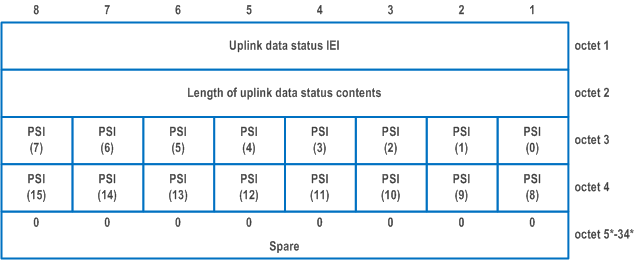
| PSI(x) shall be coded as follows: | |
| PSI(0): | |
| Bit 1 of octet 3 is spare and shall be coded as zero. | |
| PSI(1) - PSI(15): | |
| 0 | indicates that no uplink data are pending for the corresponding PDU session identity or the PDU session is in PDU SESSION INACTIVE state or is in PDU SESSION ACTIVE state with user-plane resources already established. |
| 1 | indicates that uplink data are pending for the corresponding PDU session identity and the user-plane resources for the corresponding PDU session are not established, or the UE has active multicast MBS session(s) associated with the corresponding PDU session. |
| All bits in octet 5 to 34 are spare and shall be coded as zero, if the respective octet is included in the information element. | |